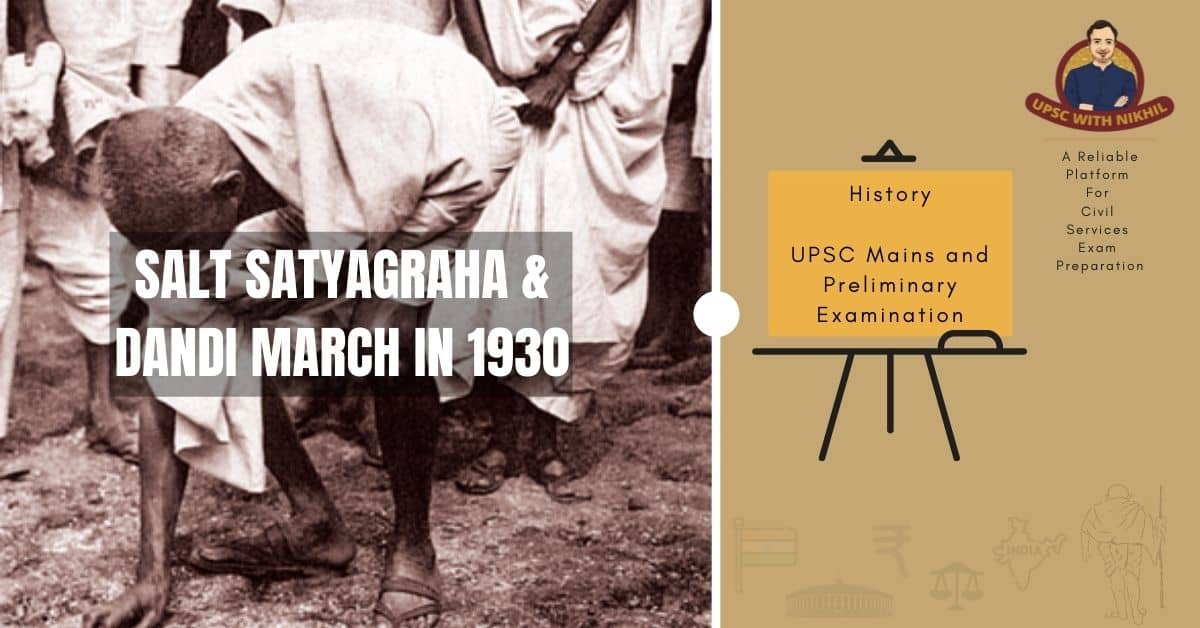Salt Satyagraha & Dandi March In 1930
The Working Committee was authorised by the Lahore Congress in I929 to launch a programme of civil disobedience, including non-payment of taxes. It also demanded that all members of legislatures resign their positions. The Working Committee, meeting at Sabarmati Ashram in mid-February 1930, gave Gandhiji full authority to launch the Civil Disobedience Movement at any time and place he chose. “Desperately seeking an effective formula,” said the acknowledged expert on mass struggle.
Gandhi ultimatum to Lord Irwin on the 31st of January, which stated the minimum demands in the form of 11 points, had been ignored, and there was now only one option: civil disobedience. The formula began to emerge by the end of February, when Gandhiji began to speak about salt: ‘There is no article outside water like salt by taxing which the State can reach even the starving millions, the sick, the maimed, and the utterly helpless.' As a result, the tax is the most inhuman poll tax that human ingenuity can devise.

Dandi march:
• On the 2nd of March, Gandhiji delivered his historic address to the Viceroy, in which he first explained why he saw British rule as a curse: ‘It has impoverished the dumb millions by a system of progressive exploitation . . . It has reduced us politically to serfdom. It has sapped the foundations of our culture . . . it has degraded us spiritually.’
• He then informed the Viceroy of his plan of action, as he believed every true Satyagrahi must: ‘...on the 11th day of this month. I shall proceed with such co-workers of the Ashram as I can take, to disregard the provisions of the salt laws. It is, I know; open to you to frustrate my design by arresting me. I hope that there will be tens of thousands ready, in a disciplined manner, to take up the work after me, and, m the act of disobeying the Salt Act to lay themselves open to the penalties of a law that should never have disfigured the Statute-book.’
• Though few realised the significance of the plan when it was first announced, it was brilliantly devised. Gandhiji was to march 240 miles from his headquarters in Ahmedabad through the villages of Gujarat with a band of seventy-eight members of the Sabarmati Ashram, among who were men from almost every region and religion in India.
• He would break the salt laws by collecting salt from the beach when he arrived at Dandi's coast. The seemingly innocuous manoeuvre turned out to be devastatingly effective.
• Thousands flocked to the Sabarmati Ashram even before the march began, anticipating the dramatic events that would unfold. And Gandhiji painstakingly explained his plans, gave directions for future action, emphasised the importance of nonviolence, and prepared the people for the government's response.
• Day after day, news of Gandhiji's progress, speeches, the throngs of people who greeted and followed the marchers, the long road lovingly strewn with leaves and festooned with banners and flags, of men and women quietly paying their homage by spinning yam on their charkas as Gandhiji passed, of the 300 village officials in Gujarat who resigned their posts in response to his appeal was carried by the press.
• By the time Gandhiji arrived in Dandi, the entire nation was awakened and anticipating the final signal.
• Gandhiji launched the Civil Disobedience Movement on April 6, 1930, by picking up a handful of salt, a movement that would go on to become unrivalled in the history of the Indian national movement for the country-wide mass participation it sparked.
• While Gandhiji was marching to Dandi, Congress leaders and workers were hard at work enlisting volunteers and members, forming grass-roots Congress Committees, collecting funds, and touring villages and towns to spread the nationalist message.
• The sites for the salt Satyagraha were chosen, volunteers were trained, and the battle logistics were worked out
The defiance of salt laws spread across the country:
1. C. Rajagopalachari, of Tamil Nadu, led a salt march from Trichinopoly to Tanjore's Vedaranniyam.
2. K. Kelappan, the hero of the Vaikom Satyagraha, walked from Calicut to Payannur to break the salt law, and by the time he was arrested on 30 April, he had gathered enough volunteers to keep the campaign going for a long time in Malabar.
3. To make salt, a group of Satyagrahis walked from Sylhet in Assam to Noakhali on the Bengal Coast.
4. In Andhra Pradesh, a number of sibirams (military-style camps) were established in various districts to serve as the salt Satyagraha's headquarters, and bands of Satyagrahis marched through villages on their way to coastal centres to defy the law. On their way back, they passed through yet another set of villages.
Local leaders used the Government's failure to arrest Gandhiji for breaking the salt law to convince the people that "the Government is afraid of persons like us," and that "the Government has disappeared and hidden itself somewhere since the beginning of the salt Satyagraha, and that Gandhi Government has already been established." 9 The arrest of Jawaharlal Nehru on 14 April for defying the salt law sparked massive protests and clashes with the police in Madras, Calcutta, and Karachi.


